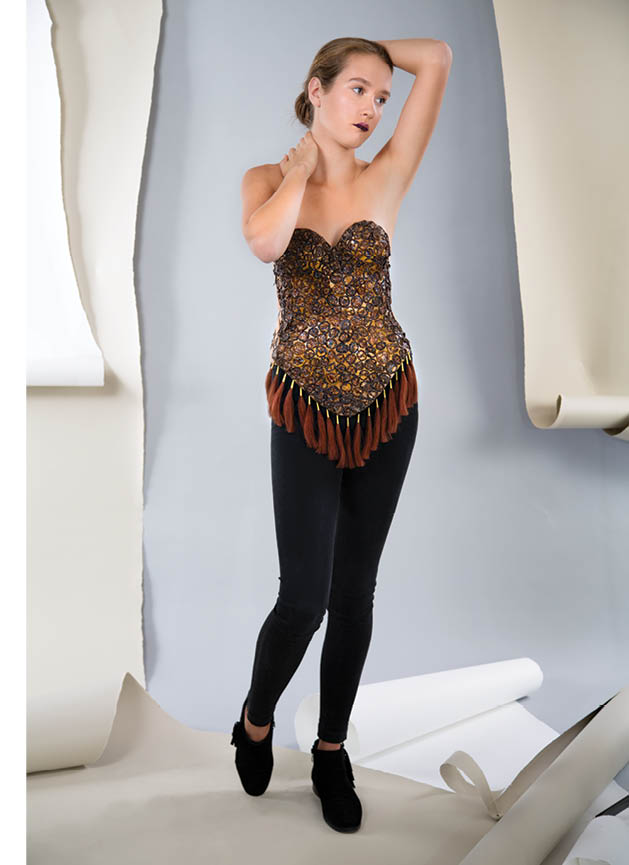Tomatoes, steeped tea bags, dehydrated sardines, postage stamps and human hair are just some of the materials artist Erica Spitzer Rasmussen uses to fashion her one-of-a-kind creations. The studio artist is also a full-time professor who has taught art appreciation courses at Metropolitan State University in St. Paul for the past 18 years. Spitzer Rasmussen also acknowledges she has been blessed since a young age by an appreciation of art from those around her, who encouraged her to pursue her calling as a paper and textile artist.
“I’m so blessed that I have creative people around me,” she says. “My mother [Nancy MacKenzie] was a fiber artist, my stepdad is a potter, my husband’s a painter, and my brother and his wife are both writers. Nobody said to me ever, ‘Erica, you can’t be an artist.’ Everybody said, ‘You can, and we will help you.’ ”
It was when Spitzer Rasmussen was in graduate school with an emphasis in drawing and painting that she felt frustrated working two-dimensionally. It was then she had a light bulb moment: Her interest had always been in the human body. Realizing her art should reflect that, she revisited the process of papermaking, a medium she felt could convey the human form more directly.
From there, Spitzer Rasmussen began fashioning the remarkable items she continues to create today. Each work of art has its own story and each piece is typically inspired by significant life events. Such pieces include “Dreaming of Sleep,” a nightgown made entirely of copies of her own prescription for sleep medication, ”Spoiler,” an intricately embellished corset made with hand-sewn buttons and human hair, and “Mail Order Bride,” a gown assembled completely from a collection of canceled postage stamps.
“My artwork is generally autobiographical, so it often starts with my own experiences or what’s happening around me, and making the work is often a cathartic experience,” she says. “I’m usually trying to work through an issue and trying to understand a situation a little bit better, and if I ruminate on something for as long as it takes me to make a work, sometimes three to six months, I usually have some resolution in my life.”
Spitzer Rasmussen shares a personal account of how clothing can be used as a metaphor and convey deeper meaning. “I always think of garments as a second skin. It references the body, it mimics the body,” the artist explains.

The talented Erica Spitzer Rasmussen with Victim of Circumstance, mixed media with handmade paper (cotton, tissue paper, matte medium, silk suture thread and surgical needles).
Spitzer Rasmussen found herself making a dress from handmade paper and other materials at a point in life when she was struggling with infertility. The garment came to be known as the “Juju dress,” because she sought supernatural forces to aid her in her difficulty. “Juju” is the West African word for “magic.”
Each diamond-shaped “plate” on the dress is made from gold-tinted paper and emulates a coat of chain mail, an homage to 15th century Italian armor. Additionally, a childhood memory surfaced: She and her friends believed swallowing a watermelon seed would cause pregnancy. So each of the pieces is threaded together with watermelon seeds tied at every juncture. “Seeds are universal symbols of fertility, so it was what I needed,” she says. She would wear the Juju dress to every doctor appointment.
“And I have to report that something worked,” she smiles. Shortly after the assembly of the dress, her son was conceived.
The uniqueness and originality of Spitzer Rasmussen’s work has led to her involvement with the American Craft Council (ACC), a nonprofit organization founded to promote artists and help champion their craft, according to Pam Diamond, ACC marketing director. Spitzer Rasmussen has curated a show of local textile artists for the ACC, as well as mounted her own show and contributed to their Project Upcycle Exhibit.
“Erica is a treasure in this community. We have definitely exhibited her work, [which is] so thoughtful and unique; she is trying to tell a story using very unusual materials. Her anchovy bustier is probably one of my favorite pieces,” says Diamond.
Bryan Starry is a senior at Metropolitan State University double-majoring in math and studio arts. He appreciates Spitzer Rasmussen as a teacher and her ability help students unlock hidden artistic talents. “She places a high priority on her students developing constructive and positive critiquing skills, along with their ability to seriously discuss and communicate about art,” Starry says.
One of the most meaningful projects Spitzer Rasmussen recently completed was a series of four hand-made paper coats, each marked by a different anatomical symbol: lungs, bones, the heart, and finally, wings. The series, “Battle Scars,” is about her mother, who passed away in 2014 from cancer. “It was about watching my mom suffer for as long as she did. My mother was one of my closest friends in life,” Spitzer Rasmussen says.
Spitzer Rasmussen is honored that her art has given her opportunities all over the country and the world. “I think making art is probably the most constructive way I know of dealing with the difficulties of life,” she says. “To make something beautiful out of a bad situation is generally a constructive act. In the end, the work goes on view and that completes the circle of communication. And then I find that people often connect with the work; [They] often say, ‘Thank you, I related to that.’ ”

Corset of Talis, mixed media with handmade paper (cotton, acrylics, gold leaf, shellac, hose hair, jute and dehydrated cherry tomatoes).
Special thanks:
Model Hair and Makeup styling by Kristine Loehrer
Model Alessandra Costalonga Provided by Moore Creative Talent









